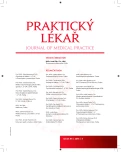-
Medical journals
- Career
Aortic dissection in routine practice
Authors: J. Vondrák; P. Vojtíšek
Authors‘ workplace: Kardiologické oddělení ; Primář: MUDr. Petr Vojtíšek, CSc. ; Pardubická krajská nemocnice a. s., Pardubice
Published in: Prakt. Lék. 2015; 95(3): 100-105
Category: Of different specialties
Overview
Aim:
To obtain information about the progress and results of treatment of aortic dissection in the present.Methods:
We performed a retrospective analysis of 38 patients with aortic dissection who were hospitalized in our department for the last 10 years, from 2003 until the end of 2012.Results:
There were 22 patients with type A aortic dissection according to the Stanford classification, with type B dissections 16. The age in both groups was similar 65 or 66 years, males predominated over women. Arterial hypertension clearly dominated of the risk factors in both groups. In one case we recorded an iatrogenic cause. Our patients most often presented with chest pain, in the second group with backache and stomachache as well. Precordial murmur was dominated in physical finding in the first group, while most patients in the second group had no physical findings. Pulse deficits were a rare find. The computed tomography was the most used diagnostic method. Level of D-dimer was high on average, but we recorded low values in patients with symptoms lasting longer than 24 hours. Complications associated with aortic dissection were more common in the first group. 18 patients of 38 died (47%). There were 22 patients who underwent surgery or interventional procedures with 30-day mortality 32%, which was at the time a downward trend.Conclusion:
Aortic dissection is currently associated with an acceptable operating decreasing mortality. The predominant clinical sign is sudden pain. The preferred diagnostic method is CT aortography. The recommended biochemical marker is plasma levels of D-dimer with a cutoff value of > 500 ng/ml. A negative value does not exclude aortic dissection.Keywords:
aortic dissection – Stanford classification – surgery – mortality – conservative approach
Sources
1. Steiner I. Kardiopatologie pro patology i kardiology. Praha: Galén 2010; 99–102.
2. Vilacosta I, San Román JA, Ferreirós J, et al. Natural history and serial morphology of aortic intramural haematoma: a novel variant of aortic dissection. Am Heart J 1997; 134 : 495–507.
3. Erbel R, Alfonso F, Boileau C, et al. Diagnosis and management of aortic dissection. Recommendations of the Task Force on Aortic Dissection, European Society of Cardiology. Eur Heart J 2001; 22 : 1642–1681.
4. Nienaber CA, Eagle KA. Aortic dissection: new frontiers in diagnosis and management. Part I: From etiology to diagnostic strategies. Circulation 2003; 108 : 628–635.
5. Benedík J. Akutní aortální disekce. Praha: Triton 2006; 21–45.
6. Popelová J, Benešová M, Brtko M, a kol. Doporučené postupy pro diagnostiku a léčbu chlopenních srdečních vad v dospělosti. Cor Vasa 2007; 49(Suppl 11): 204–205.
7. Braverman AC. Acute aortic dissection: clinician update. Circulation 2010; 122 : 184–188.
8. Vojáček J, Kettner J, a kol. Klinická kardiologie. Hradec Králové: Nucleus 2009; 902–904.
9. Beller CJ, Labrosse MR, Thubrikar MJ, et al. Role of aortic root motion in the pathoenesis of aortic dissection. Circulation 2004; 109 : 763–769.
10. Vejvoda J, Alan D, Ošťádal P. Disekce aorty. Interv Akut Kardiol 2005; 4 : 159–165.
11. Tsai T, Nienaber CA, Eagle KA. Acute aortic syndromes. Circulation 2005; 112 : 3802–3813.
12. Bekkers JA, Raap GB, Takkenberg JJ, Bogers AJ. Acute type A aortic dissection: long-term results and reoperations. Eur J Cardiothorac Surg 2013; 43 : 389–396.
13. Suzuki T, Distante A, Zizza A, et al., for the IRAD-Bio Investigators. Diagnosis of acute aortic dissection by D-dimer: the International Registry of Acute Aortic Dissection Substudy on Biomarkers (IRAD-bio) experience. Circulation 2009; 119 : 2702–2707.
14. Sodeck G, Domanovits H, Schillinger M, et al. D-Dimer in ruling out acute aortic dissection: a systematic review and prospective cohort study. Eur Heart J 2007; 28 : 3067–3075.
15. Bekkers JA, Raap GB, Takkenberg JJM, et al. Acute type A aortic dissection: long-term results and reoperations. Eur J Cardiothorac Surg 2013; 43 : 389–396.
16. Hazui H, Nishimoto M, Hoshiga M, et al. Young adult patients with short dissection length and thrombosed false lumen without ulcer-like projections are liable to have false-negative results of D-dimer testing for acute aortic dissection based on a study of 113 cases. Circ J 2006; 70(12): 1598–1601.
Labels
General practitioner for children and adolescents General practitioner for adults
Article was published inGeneral Practitioner

2015 Issue 3-
All articles in this issue
- Occupational diseases reported in the Czech Republic in 2014
- Health services research as scientific discipline in the Czech Republic and Slovakia
- Comparison of risks from smoking cigarettes and water pipe
- Reliability of clinical indicators of neonatal sepsis
- Aortic dissection in routine practice
- Sexual dysfunctions following sphincter-preserving rectal resection
- Microbiome, respiratory allergy, and a perspective of treatment
- General Practitioner
- Journal archive
- Current issue
- Online only
- About the journal
Most read in this issue- Comparison of risks from smoking cigarettes and water pipe
- Aortic dissection in routine practice
- Reliability of clinical indicators of neonatal sepsis
- Microbiome, respiratory allergy, and a perspective of treatment
Login#ADS_BOTTOM_SCRIPTS#Forgotten passwordEnter the email address that you registered with. We will send you instructions on how to set a new password.
- Career

